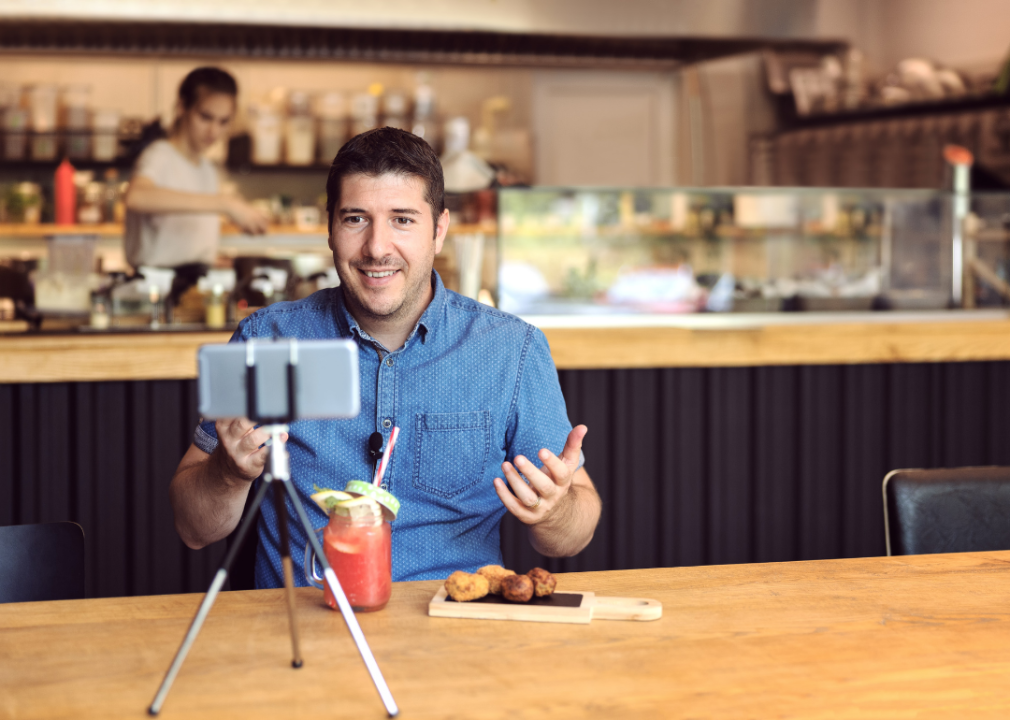10 ways to build your brand on social media
Canva
10 ways to build your brand on social media
There are many benefits of using social media to grow a business and to craft an online persona that showcases a brand’s values and services. A defined social media strategy can help businesses be more profitable, establish credibility, and gain a strategic edge over the competition. Social media has become a powerful tool in marketing as it’s accessible anytime, anywhere, and is a fun, engaging way to share and collect information.
According to the most recent data from Statista, as of 2021, 82% of the U.S. population has a profile on social media, with the most popular platform being Facebook. In 2021, nearly 92% of U.S. marketers were expected to use social media for marketing purposes.
Planoly consulted research from social media influencers, brand managers, and marketing agencies to compile 10 of the best ways to start building your brand on social media.
There are various strategies for companies and brands to up their social media marketing game. It can be something as simple as taking more time getting to know your audience and creating content accordingly, or following and engaging with accounts that may be similar and relevant to your brand. It also helps to include relevant hashtags—though you don’t go overboard with them in posts. Be sure to include hashtags that will be of interest to your target audience.
A copy-and-paste approach may seem ideal when posting content across various social platforms, but sometimes it helps to take the time to curate and differentiate content for each respective platform. What draws attention on Facebook may fall into the ether on Twitter and vice versa. Giving your social accounts a more authentic feel may require a more unique posting method based on your target audience.
Continue reading for 10 strategies you can use to build your brand on social media.
![]()
Canva
Determine your specialty
Influencers on social media tend to specialize in a certain area—whether it’s the beauty, parenting, or financial coaching spaces, specificity is key. Finding a niche can sometimes be challenging for one with myriad interests, but it helps for an influencer to hone in on a specific audience and establish authority. Your niche is what you’re genuinely interested in and what suits your personality.
After deciding what you want to focus on, begin creating your posts around that topic. It helps to tag other accounts closely related to your topic of interest.
Canva
Know your audience and demographic
What does your business know about its customers? What are their age groups? Where are they located? These are questions that companies need to ask in order to learn about their customers.
In terms of selecting influencers to represent their brand, companies will want to partner with influencers followed by the same group of people who purchase its products and services. Influencers who are authentic, engaging, and who have an understanding of the brand will be key to the success of the company’s social media campaigns.
Canva
Target the right social media platforms for your brand
It’s important for a business to know the demographics of its target market when deciding which social media channels to use. Brands that are more visual may lean toward Instagram and TikTok, while brands focused on real-time events may find Twitter to be more suitable.
It’s beneficial to define social media goals and to figure out the social media channels the company’s audience uses in order to develop a receptive audience. Take time to analyze the type of content the business is posting on its channels and how the content works for each social media platform.
As of 2021, for business-to-business companies, Facebook and LinkedIn tend to be the preferred social media platforms. For business-to-consumer companies, Facebook and Instagram were the most popular platforms.
Worawee Meepian // Shutterstock
Define your brand’s voice and tone
A brand’s target audience is the most crucial aspect of developing a voice and tone. Put yourself in the shoes of your audience and consider what would inspire them to take action to buy your company’s product or follow your brand.
Often, companies take more of a general approach, directing social media posts to a broad audience, but catering to more niche users may work better. Brands need to think of what it is they wish to accomplish—when the dust settles, what is the primary purpose?—and how the answer to that question can resonate long-term with its audience.
Jacob Lund // Shutterstock
Connect with influencers in your industry
Networking on social media has been a way for many companies to get their name out there and build brand recognition. It’s no different when influencers decide to join forces, even if just for one specific event. It can be highly beneficial to collaborate with fellow industry influencers, whether it’s launching a cross-promotional giveaway experience or appearing on another influencer’s podcast.
Whether you’re looking to expose your business to a bigger audience, generate leads, or boost traffic to your blog, partnering with fellow influencers with a similar target audience can be impactful. Collaboration can diversify an influencer or company’s possibilities, build connections, and create more opportunities overall.
Canva
Identify which products or services you want to promote
For the most part, influencers work independently and generate their own content while integrating a brand’s marketability. For relevant influencers, creating content takes time; therefore, a brand must recognize and value the work required in growing that influencer’s following and establishing their voice.
When it comes to promoting products and services, in-demand influencers tend to lean toward companies that offer paid partnerships in addition to complimentary products. This is not to say that influencers will only work with a company that gives away free products, but the pull of a partnership arrangement is certainly a more attractive, mutually beneficial arrangement.
Canva
Pay attention to trends in social media and video content
Companies should focus on trends to better hone their marketing efforts. Some trends include the rise of short video content shared on platforms, such as TikTok, or via Instagram Stories and Youtube Shorts, all of which have resonated with marketers and brands, notably throughout the pandemic.
The e-commerce option for social media platforms has also taken off as brands can connect their online store with their brand’s social media account, removing the need for a third-party website. Paid advertising on social media also gives brands the opportunity to showcase content in front of a target audience.
Kaspars Grinvalds // Shutterstock
Be consistent with your social media posts
It can be challenging to post consistently on social media, especially when managing several social platforms or multiple accounts across platforms. But consistency is key when it comes to audience recognition and follower growth and retention.
Posting strategically and consistently maximizes your organic reach, which is the number of people you reach without paying for an ad or boosting a post. Scheduling your content ahead of time with news or upcoming events can make it feel more timely. Planning in advance also allows you to keep a steady stream of posts in front of your audience at times when you may not be online.
oatawa // Shutterstock
Engage with your consumers and followers
Engagement develops customer relationships, builds trust, and helps businesses reach a larger audience. It’s also a quick way for companies and influencers to receive feedback on what’s resonating with their target audience. Some ways that companies and influencers engage on social media is through responding to comments, sharing content, responding to direct messages, and creating polls to generate responses on insights for particular topics.
In most cases, engagement is often more important in terms of impact than the number of followers, as a business can have 20,000 followers on social media with zero engagement. This results in a low return on investment. But if there are, say, 5,000 followers with much higher engagement, a higher ROI makes the business appear more credible and not like there’s a bunch of ghost followers.
AlesiaKan // Shutterstock
Define your metrics of success and use them to inspire future content
In recent years, social media has served as a major tool for businesses and influencers to have a better understanding of their audience. There are ways to analyze social media data through built-in insights and analytics that are provided by most social platforms. These findings show information such as demographics, impressions, and reach, all of which are essential metrics for building an audience.
Analytics and metrics help to track progress, such as the speed at which you’re building an audience and which posts are performing better than others. The posts that do well can be an example of what may work for similar future posts.
Social media engagement can be a war of attrition, so weeding out content that is not engaging your target audience will result in a stronger overall profile and present an image of brand authority.
This story originally appeared on PLANOLY
and was produced and distributed in partnership with Stacker Studio.










